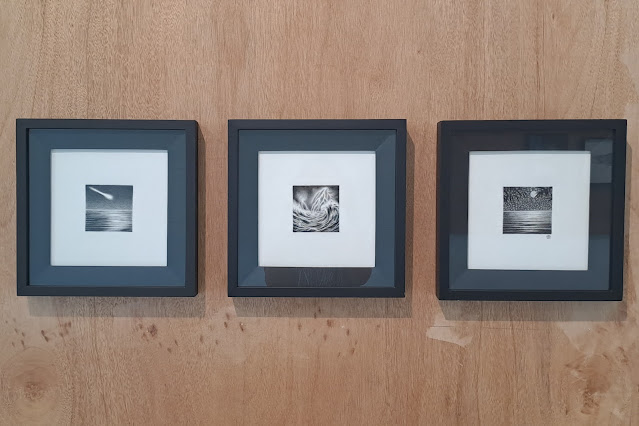Waters of Memory and Myth: Gender, Faith, and Identity in Two Powerful Exhibitions at UP Vargas Museum
 |
| Artists Ampannee Satoh (TH) and Lee Paje (PH) |
Two exhibitions at the UP Vargas Museum—Ports of Refuge by Thai artist Ampannee Satoh and Beyond the Edge, Embodied Horizons by Filipino artist Lee Paje—offer intimate explorations of identity, history, and the body. Though coming from different contexts and artistic strategies, both shows reflect on how personal and collective stories intersect across gender, religion, and place.
 |
| Portraits of Ampannee Satoh of port cities La Rochelle, France and Pattani, Thailand. |
Ports of Refuge: Tracing Invisible Histories
Ampannee Satoh’s Ports of Refuge is a quiet, contemplative exhibition. At first glance, her black-and-white photographs appear minimal and serene. But beneath their stillness lies a deep engagement with political histories and personal memory.
Satoh, who hails from Pattani in southern Thailand—a region with a majority Muslim population and a complex history of resistance against Thai state control—created this series during her residency in La Rochelle, France. While seemingly worlds apart, both Pattani Bay and La Rochelle share surprising historical parallels. Each is a coastal city deeply shaped by maritime trade, religious tensions, and struggles over identity.
La Rochelle was once a center of Huguenot Protestant resistance during France’s religious wars and later became a key port in the transatlantic slave trade. Today, it is a picturesque tourist destination, home to a university and known for its environmental initiatives. Pattani, on the other hand, has long been a site of cultural resilience for the Malay-Muslim minority in Thailand, who continue to face marginalization and cultural erasure under state-led policies of assimilation.
Satoh’s photographs act as meditative witnesses to these fraught legacies. One image captures the back of a woman in full body covering—her presence defiant yet elusive. This figure serves as a powerful counterpoint to France’s controversial ban on full-face coverings, including burqas and niqabs. Enacted in 2011, the law was justified under the principles of secularism and public safety, but in practice, it disproportionately affects Muslim women, and has drawn criticism from human rights advocates worldwide.
In this context, Satoh’s photographs do not simply
document—they protest. They recover the emotional and spiritual weight of
veiled presence in public space. They remind us that bodies are always read in
cultural context, and that even silence can speak volumes.
 |
| Close up shot of Lee Paje's installation Unfolding |
Embodied Horizons: Rewriting the Myths
In the gallery adjacent to Satoh’s work, Beyond the Edge, Embodied Horizons by Lee Paje offers a different, but equally resonant, exploration of identity. Developed during her residency in Leipzig, Germany—following her participation in the 10th Asia Pacific Triennial of Contemporary Art in Australia—Paje’s show engages with myth, gender, and the ongoing process of reimagining the self.
Paje uses expanded printmaking techniques and sculptural etchings to reinterpret creation myths. Her practice is rooted in storytelling but pushes against the boundaries of traditional narrative. Instead of linear tales, her works unfold like constellations—inviting viewers to engage, interpret, and find their own entry points.
Her materials are tactile and intimate, and her forms often suggest fluid, transforming bodies—merging flesh with landscape, myth with memory. In these pieces, water becomes both metaphor and medium: symbol of birth, change, and interconnectedness. It flows through her compositions just as it flows through cultural memory.
Paje’s work questions how social norms about gender have been built from these inherited stories. Who gets to tell them? Who gets to change them? And how do myths serve to reinforce or resist systems of power?
 |
| Lee Paje's First Light |
A Shared Horizon
Though distinct in approach and theme, Satoh and Paje’s exhibitions resonate with each other. Both artists delve into forgotten or silenced histories, drawing attention to how personal identity is shaped by larger social and political forces. Both engage the body—whether through its absence, transformation, or cultural coding—as a site of resistance and renewal.
Their shared imagery of water is not accidental. As a literal and symbolic motif, water speaks to passage, migration, memory, and myth. For an archipelagic nation like the Philippines, and for many Southeast Asian contexts, water is not just background—it’s central to who we are and how we navigate the world.
Together, Ports of Refuge and Beyond the Edge, Embodied Horizons invite viewers to consider not only where we come from, but how we carry those origins with us—across borders, across bodies, and across generations.
These two timely and beautifully executed exhibitions were on view at the UP Vargas Museum until June 21, 2025.
This article is self-published by the author. All texts and photos are the author's own.
If you enjoyed this article, consider supporting my independent work through Buymeacoffee
Comments